Apple iPhone 4S: Thoroughly Reviewed
by Anand Lal Shimpi & Brian Klug on October 31, 2011 7:45 PM EST- Posted in
- Smartphones
- Apple
- Mobile
- iPhone
- iPhone 4S
Display
Though many expected Apple to redesign everything around a 4“ display, the display on the 4S superficially identical. The 4S includes the same size and resolution display as the 4, namely a 3.54” IPS panel with 960x640 resolution. We’ve been over this a few times already in the context of the iPhone 4 and the CDMA iPhone 4, but it bears going over again.
In retrospect, moving up to 4“ would’ve gone against Apple’s logical approach to maintaining a DPI-agnostic iOS, and it makes sense to spread the cost of changing display resolution across two generations, which is what we see now. While Android is gradually catching up in the DPI department, OEMs on that side of the fence are engaged in a seemingly endless battle over display size. You have to get into Apple’s head and understand that from their point of view, 3.5” has always been the perfect size - there’s a reason it hasn’t changed at all.
I’ve been through a few 4s myself, and alongside the CDMA iPhone 4, have seen the white point of the retina display gradually shift over time. While I don’t have that original device anymore, even now the 4S seems to have shifted slightly compared to a very recently manufactured 4 I had on hand, and appears to have a different color temperature. We’ve been measuring brightness and white point on smartphone displays at a variety of different brightness settings, and the 4S isn’t spared the treatment. I also tossed in my 4 for comparison purposes. The data really speaks for itself.

The first chart shows white point at a number of brightness values set in settings. You can see the iPhone 4 and 4S differ and straddle opposite sides of 6500K. I would bet that Apple has some +/- tolerance value for these displays from 6500K, and the result is what you see here. Thankfully the lines are pretty straight (so it doesn’t change as you vary brightness), but this variance is why you see people noting that one display looks warmer or cooler than the other. I noted this behavior with the CDMA iPhone 4, and suspect that many people still carrying around launch GSM/UMTS iPhone 4 devices will perceive the difference more than those who have had their devices swapped.
The next two charts show display brightness at various settings for solid black and white on the display.
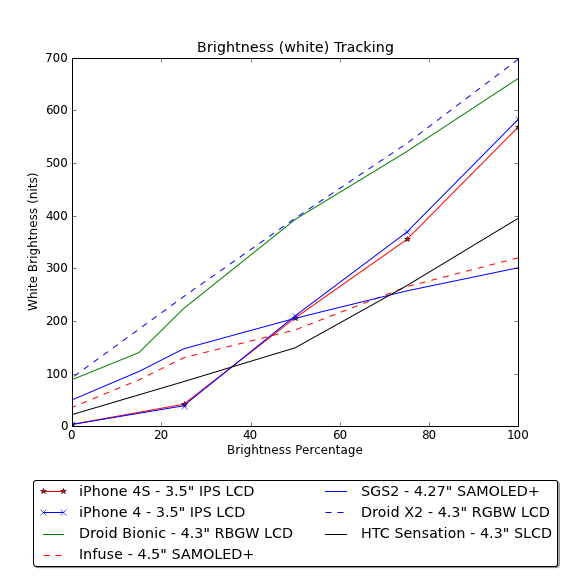
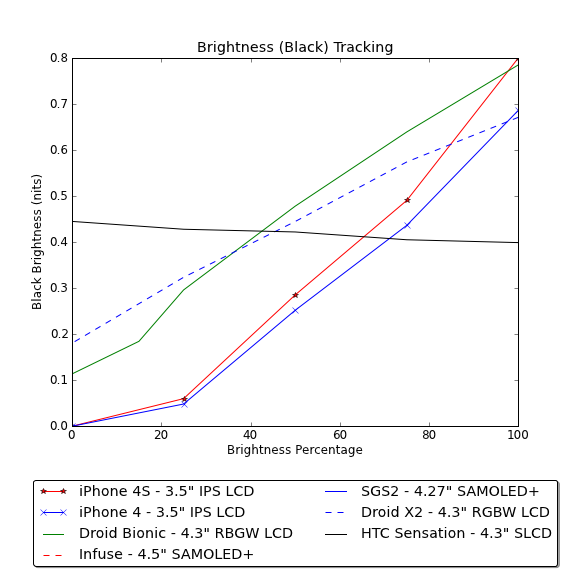
The 4S and 4 displays follow roughly the same curve, however there is a definite shift in contrast resulting from higher black levels on the 4S display. I’ve seen a few anecdotal accounts of the 4S display being less contrasty, and again this is the kind of shift that unfortunately happens over time with displays. I’ve updated our iPhone 4 result on the graph with the latest of a few I’ve been through.
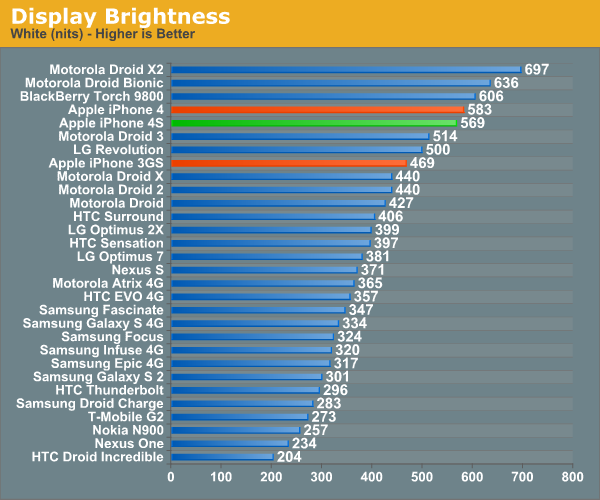
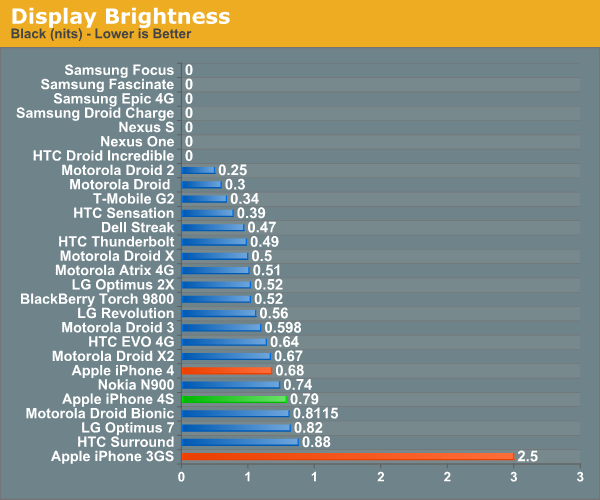
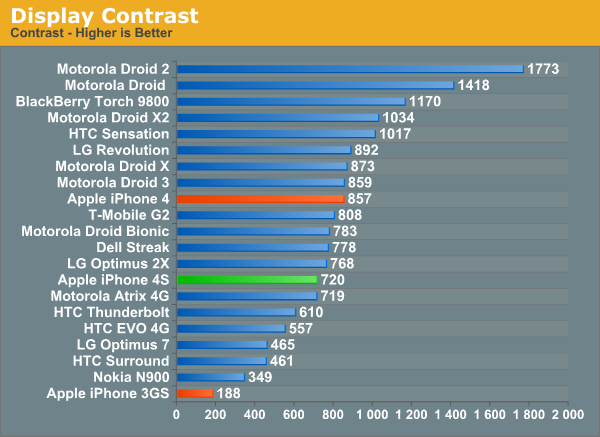
Unfortunately the 4S falls short of the quoted 800:1 contrast ratio, whereas the 4 previously well exceeded it (the earliest 4 we saw had a contrast value of 951). Rumor has it that Apple has approved more panel vendors to make the retina display, I have no doubt that we’re seeing these changes in performance as a result of multiple sourcing.










199 Comments
View All Comments
Formul - Monday, October 31, 2011 - link
There is about a dozen fairly similar android phones every month. As iPhone gets refreshed just once every year (this time year and a half) and has bigger market than any single android phone out there it makes sense to make the review thorough. I guess Nexus Prime and even Razer will get similar lengthy reviewsa ... as did many other android phones before that (galaxy s2 for example had about the same as this one).You are the one biased here. Counting the number of android articles on any gadget blog will seriously outpace the iPhone by far. You should shut up and read what you want, no one is forcing you to read this blog or any particular article on it. I dont read android articles, i dont care about android all that much. Why do you have to troll here if it does not interest you after all?
Anand Lal Shimpi - Monday, October 31, 2011 - link
I believe we did just that for the Galaxy S 2 review:http://www.anandtech.com/show/4686/samsung-galaxy-...
We don't have the RAZR, Galaxy Nexus or S2 Skyrocket, but we typically do a deep dive whenever there's a new platform transition or something truly unique to look at.
Take care,
Anand
LordSojar - Tuesday, November 1, 2011 - link
Hmm, touche Anand, I had forgotten about how detailed the S2 review was.The RAZR doesn't warrant a particularly detailed review I suppose, but I think the S2 Skyrocket might warrant a detailed antenna review etc considering the transition to LTE along with, what should be a major change to the antenna and should (I think) have QC's MDM9615 or MDM8215 chips in it... which is a big deal considering those could yield not only significant speed gains along with an antenna update, but some major throughput.
Cheers
doobydoo - Tuesday, November 1, 2011 - link
'Samsung releases a new phone that has overall better features, faster CPU, faster NAND, a different and arguably better (or at least equal) screen'I hope you are comparing to the OLD Samsung, in this sentence, rather than comparing to the iPhone 4S.
The CPU/GPU performance of the iPhone 4S is not comparable to the Galaxy S2, and I would argue the features are very much superior too.
Which, incidentally, along with the dual-antenna design, Siri, brand new camera, makes the iPhone 4S much more of a step up than the Samsung Galaxy to Samsung Galaxy S2. (The Galaxy S was about the same performance as the iPhone 4. The Galaxy S2 is slower than the iPhone 4S, therefore iPhone 4S is a bigger upgrade).
And of course, as Anand said, they thoroughly review most phones, and as the other poster says, the Android phones come out way more often so over the same length of time they get at least as much if not more coverage.
Tetracycloide - Tuesday, November 1, 2011 - link
The Galaxy S2 released in May. The 4S released in October. The next Galaxy phone, the generation the 4S is actually going to compete with, is the Galaxy Nexus. What I'm saying is your point would hold more water (or any at all) if Samsung didn't make 2 upgrades in the space of time it took Apple to do 1 so the differential between generations is hardly an apples to apples comparison (pun intended).thunng8 - Tuesday, November 1, 2011 - link
But the Galaxy Nexus isn't any faster than the S2. The main benefit is the new operating system and higher resolution screen.The Nexus is actually a significant step backwards from the S2 in terms of camera (likely from the samples on the prototype) and GPU (definitely since it is using the SGX540) performance
doobydoo - Wednesday, November 2, 2011 - link
Release dates will not stop phone users comparing the iPhone 4S to the Androids released in March 2012, just like they compared all the Androids over the last 17 months to the iPhone 4.The iPhone 4S, right now, is competing with the Galaxy S2 directly.
The Nexus Prime, as the other comment alluded to, is a significant downgrade from the Samsung Galaxy S2. Indeed, it uses the same GPU as used in the much older Samsung Galaxy S (albeit clocked higher).
The Galaxy S to S2 took approximately a year inbetween generations (June 2010 to May 2011), which is very much in line with the typical Apple release cycle of annually (this year was the exception). Even this year, with the extended timeline between iPhone 4 and 4S, Samsung didn't make 2 upgrades during that time. Your point would hold more water (or any at all) if it had.
Tetracycloide - Wednesday, November 2, 2011 - link
It's obvious you're not making a real comparison between current products but instead of admitting that you pretend it's a non-issue and then strangely fought that issue anyway by suggesting I'm not actually right to call you out on these shenanigans. So thanks for being obtuse about this, it makes it much easier to dismiss your position as that of an irrational fan-boy (at least it does when combined with the condescension in some of the other threads you've commented on here).doobydoo - Friday, December 2, 2011 - link
'It's obvious you're not making a real comparison between current products'Erm, huh?
That's EXACTLY what I'm doing.
What YOU'RE doing is asking is to compare a phone which isn't even out yet with a phone which is. You're trying to 'pretend it's a non-issue' that the phone you say the iPhone 4S should be compared with wasn't even out when this discussion started. THAT is the definition of fanboy-ism. It's like the constant like of Android fans 'x WILL be better when it eventually comes out' - and THAT is obtuse.
So, the only comments which can be dismissed are YOUR fanboy comments about 'x phone released in x months will be better'. Turns out you were wrong anyway, but that's irrelevant - the bottom line is you don't want iPhone to be compared to CURRENT Android phones, but instead compared to FUTURE ones.
Rational, much?
As it happens, it's out now, and isn't even much of an improvement on the Samsung Galaxy S2
Lucian Armasu - Wednesday, November 2, 2011 - link
The cameras seem to be about the same, according to Anand. I've actually found the SGS II camera to be a bit better in photo comparisons. Siri? I still think it's more of a gimmick for now. Maybe in 5-10 years it will be actually useful. Once the novelty expires, people will barely even use it in a few months. The same happened with FaceTime which everyone went crazy about at launch, and then they stopped using it completely.The CPU of the SGS2 IS faster than iPhone 4S CPU. There's no way Apple managed to get a 50% performance improvement for the same Cortex A9 chip that Samsung is using.
I think Anand can confirm this. He wasn't very clear in the review. He was only talking about the improvements it gets over the old Cortex A8.